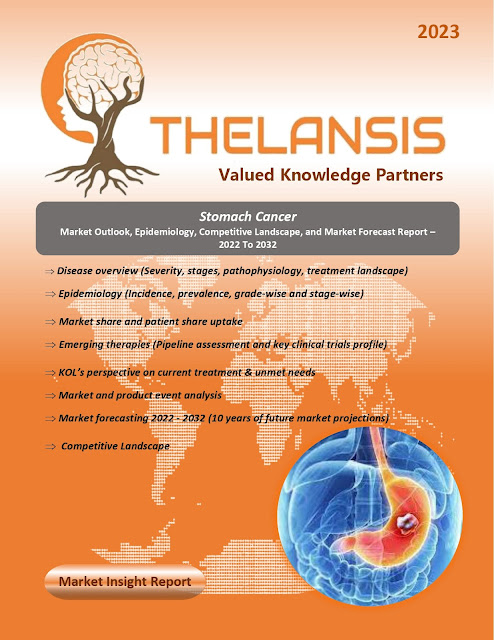Stomach Cancer – Market Outlook, Epidemiology, Competitive Landscape, and Market Forecast Report – 2022 To 2032
Stomach cancer, also known as gastric
cancer, is a malignancy that originates from the stomach lining. It is a slow-growing
cancer and is considered a multifactorial disease. The International Agency for
Research on Cancer (IARC) has classified the bacterium Helicobacter pylori (H.
pylori) as a carcinogen in humans due to the evidence linking H. pylori
infection and an increased risk of gastric cancer. The mechanism by which H.
pylori acts as a carcinogen is believed to be indirect, through the induction
of gastritis, which can lead to the development of precancerous conditions such
as gastric atrophy, metaplasia, and dysplasia. Individuals with certain genetic
disorders, such as hereditary diffuse gastric cancer, Peutz-Jeghers syndrome,
and familial adenomatous polyposis, have an increased risk of developing
stomach cancer. Mutations or deletions in genes such as p53, BRCA2, MSH2, and
MLH1 also increase the risk of gastric cancer. The symptoms of stomach cancer
can be classified into two stages: early stage and advanced stage. The most
common type of stomach cancer is adenocarcinoma, which accounts for
approximately 90% of all cases. Other types of stomach cancer include gastric
lymphomas, gastrointestinal stromal tumors, and carcinoid tumors. The risk factors
for developing stomach cancer include age, gender, H. pylori infection, family
history/genetics, race/ethnicity, diet, previous surgery or health conditions,
occupational exposure, tobacco and alcohol use, and obesity. The five-year
survival rate for individuals diagnosed with stomach cancer is 31.2%.
·
The estimated incidence of stomach cancer in
the USA is 5.6 per 100,000 individuals.
Thelansis’s “Stomach Cancer Market
Outlook, Epidemiology, Competitive Landscape, and Market Forecast Report – 2022
To 2032" covers disease overview, epidemiology, drug utilization,
prescription share analysis, competitive landscape, clinical practice,
regulatory landscape, patient share, market uptake, market forecast, and key
market insights under the potential Stomach Cancer treatment modalities options
for eight major markets (USA, Germany, France, Italy, Spain, UK, Japan, and
China).
KOLs insights
of Stomach Cancer across 8 MM market from the Centre of Excellence/ Public/
Private hospitals participated in the study. Insights around current treatment
landscape, epidemiology, clinical characteristics, future treatment paradigm,
and Unmet needs.
Stomach Cancer Market Forecast Patient
Based Forecast Model (MS. Excel Based Automated Dashboard), which Data Inputs
with sourcing, Market Event, and Product Event, Country specific Forecast
Model, Market uptake and patient share uptake, Attribute Analysis, Analog
Analysis, Disease burden, and pricing scenario, Summary, and Insights.
Thelansis Competitive Intelligence (CI) practice
has been established based on a deep understanding of the pharma/biotech
business environment to provide an optimized support system to all levels of
the decision-making process. It enables business leaders in forward-thinking
and proactive decision-making. Thelansis supports scientific and commercial
teams in seamless CI support by creating an AI/ ML-based technology-driven
platform that manages the data flow from primary and secondary sources.




Comments
Post a Comment